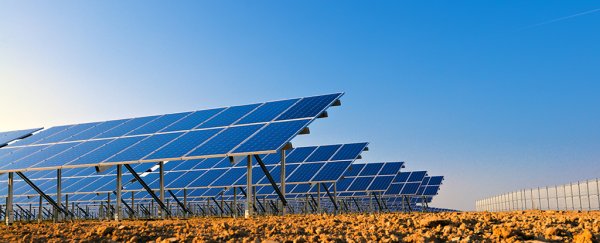Market forces often produce strange quirks in the economic system, like the one we're seeing in Chile this year: the country is producing so much solar power that it's being sold for… nothing at all.
While it's incredibly encouraging to see so much expansion in the country's renewable energy output, this huge amount of supply does actually cause problems for the companies looking to invest in solar energy.
Solar capacity on Chile's central power grid (called SIC or Sistema Interconectado Central) has more than quadrupled over the past three years to 770 megawatts – good news for the environment and customers paying their electricity bills.
Now the challenge is to upgrade the infrastructure to cope with the influx of solar energy.
As Vanessa Dezem and Javiera Quiroga report at Bloomberg, spot prices (set by supply and demand) for electricity have hit zero for 113 days this year up to the end of April. That compares with 192 days in total in 2015.
Increasing energy demands and investment followed by a slowing of economic growth means that regions are being oversupplied with power – 29 solar farms are now online in the country with a further 15 in the pipeline.
It's fantastic to see so much solar energy being produced, but next-to-nothing prices will discourage future investment and mean power plants just aren't profitable, warn experts.
The solution lies in increasing the country's ability to take on extra capacity, and there are plans to build a 3,000-kilometre (1,854-mile) transmission line to link the SIC with Chile's northern power network for the first time.
Once this is built, it'll mean that, when there is a surplus, it can be re-routed to areas that need it. Basically it's just increasing the demand on the sustainable product by giving more people access to it.
There are also transmission lines within the two grids that need to be upgraded to allow electricity to be more evenly distributed.
Chile is way ahead of other countries in Latin America when it comes to renewable energy capacity – producing more than the rest of the continent combined, according to Bloomberg's figures – which is partly helped by the abundance of sunshine, wind, and water in the country.
But they've also invested in some awesome technology that are helping them maximise these natural resources. One of the biggest renewable energy sources in the country is the Atacama-1 solar tower, in the middle of the Atacama desert.
Standing more than 200 metres (656 feet) tall, the US$1.1 billion project uses mirrors to concentrate sunlight onto a steel solar receiver that weighs 2,000 tonnes, as Jonathan Watts reports for The Guardian. Thanks to 10,600 heliostatic mirrors and 50,000 tonnes of molten salt, the tower will eventually be able to supply electricity around the clock.
As well as upgrading its infrastructure to support projects like Atacama-1, Chile has plans to export its solar power energy too: "We are in a region of the world that has huge opportunities for integration and interconnection," Chile's Energy Minister Maximo Pacheco told Bloomberg.
This is something that countries like Denmark, which has a lot of wind energy production, does in order to maintain the price of wind power even when there's a surplus.
"There are huge opportunities for Chile… [to] export some of this renewable energy to other countries in the region," added Pacheco.
What's exciting is that we're halfway there - we're getting so much better at harnessing renewable energy, now we just need to find out a way to make it a good idea economically.
